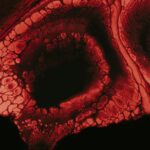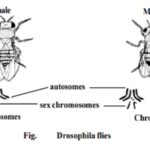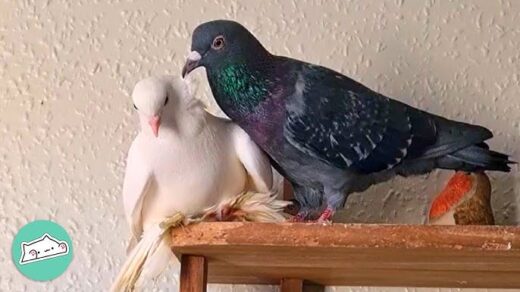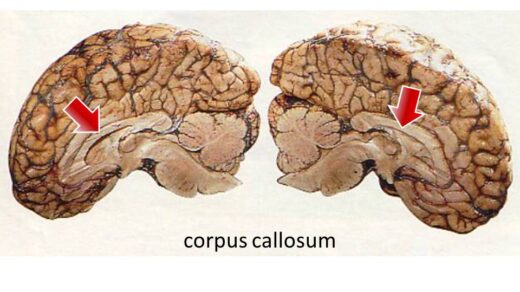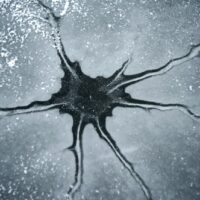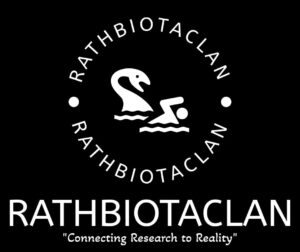A stem cell may be taken to be an approximately undifferentiated cell such that when it divides, it gives rise to one cell of undifferentiated nature; and a second cell which will undertake one or more lines of differentiation. Therefore, a stem cell can renew itself at every division so that there is always a reservoir of stem cells and also generate a daughter cell that can respond to its environment by differentiating in a specific way. (This is the potential that is not always fulfilled; in some cases, stem cells divide symmetrically in such a way that both daughter cells are stem cells.) In most cases, the stem cell stays in the niche while its sister departs from the niche and differentiates. In some organs, like the gut, epidermis, and bone marrow, stem cells continually divide to replace old cells and repair damaged tissues. In the prostate and heart, stem cells only divide under distinctive physiological conditions, typically due to stress or an urgency to replace the organ.
Biologists in the mid-twentieth century believed cell specification happened in the early embryo and that beyond this period there would only be the proliferation of already present parts. This concept is maintained in the distinction between human development into embryonic stages in which specification occurs (i.e., prior to week 9) and subsequent fetal stages that are marked by growth. But starting in the 1960s, biologists researching blood cell development started to wonder about an astonishing phenomenon. All of the blood cells- red blood cells (erythrocytes), white blood cells (granulocytes), platelets, and even lymphocytes-are being manufactured in the bone marrow at all times.
Billions of blood cells are being broken down by the spleen every hour, but an equal number of blood cells are being made to take their place. In a beautiful series of experiments, Ernest McCulloch and James TIll showed that there was a shared generative cell, the “hematopoietic (blood formingJ stem cell,” which gave rise to all of the various types of blood cells. In an experiment done in 1961, Till and McCulloch took bone marrow cells from a donor mouse and injected them into lethally irradiated mice‘ of the same genetic strain. Some of the individual donor cells formed discrete nodules on the spleens of the host animals, and the nodules contained erythrocytes, granulocytes, and platelet precursor cells. Subsequent experiments in which the donor marrow cells were irradiated to genetically label each cell with random breaks in chromosomes reinforced the finding that each of these different cell types in a nodule arose from a single cell, and that there were lymphocytes in some of these nodules (Becker et al. 1963).
For this “colony-forming cell” to be an authentic stem cell, however, it must give rise not only to the differentiated blood cells but to additional colony-forming cells as well. That this was the case was demonstrated by taking the nodule grown from a single genetically labeled colony-forming cell and injecting nodule cells into another irradiated mouse. Several spleen colonies developed, each one of them being of the same chromosomal arrangement as the initial colony (Till et al. 1964; Juraskova and Tkadlecek 1965; Humphries et al., 979). So, we observe that a single cell from the marrow is able to give rise to many different cell types and is also capable of self-renewal. This work on hematopoietic stem cells helped in the formation of the branch of bone marrow transplantation.
Stem Cell Vocabulary
There are many terms for stem cells, and the terms have not always been applied uniformly. Yet there is emerging common understanding about the usage of these terms. The names of the two large groups of stem cells have their basis in their sources. Embryonic stem cells come from the inner cell mass of mammalian blastocysts or from fetal gamete progenitor. These cells can give rise to all the cells of the embryo (i.e., a com plete organism). Adult stem cells occur in the tissues of organs once the organ has fully developed. These stem cells, which are normally responsible for replacing and repair ing tissues of that specific organ, can give rise to only a subset of cell types.
STEM CEll POTENCY
The capacity of an individual stem cell to form many different forms of differentiated cells is its potency. In mammals, totipotent cells can develop into every cell in the embryo and, besides, the placental trophoblast cells. Only the zygote and (presumably) the first 4-8 blastomeres to develop before compaction are truly totipotent. Pluripotent stem cells can differentiate into all the cell types of the embryo except trophoblast. Embryonic stem cells are normally obtained from the inner cell mass of the mammalian blastocyst. Germ cells and germ cell tumors like terato carcinomas can also give rise to pluripotent stem cells. Multipotent stem cells are stem cells whose potential is restricted to a relatively small number of all the possible body cells. They are typically adult stem cells. The hematopoietic stem cell, for example, can give rise to the granulocyte, platelet, and red blood cell lineages. Likewise, the mammary stem cell can give rise to all the various cell types of the mammary gland. There are some unipotent stem cells, which are located within specific tissues and specialize in the regeneration of a specific cell. Spermatogonia, for instance, are stem cells that develop into only sperm. While pluripotent stem cells can give rise to cells of all three germ layers (as well as to germ cells), the multipotent and unipotent stem cells tend to be classed together as committed stem cells, because they can differentiate into relatively few cell types.
PROGENITOR CELLS
While being stem cell relatives, progenitor cells cannot undergo unlimited self-renewal; they can only divide several times before they differentiate (Seaberg and van der Kooy 2003). They have been referred to as transit-amplifying cells, as they often divide as they move away from the stem cell niche. Both progenitor cells and unipotent stem cells have been referred to as lineage restricted cells, but the stem cells are capable of self-renewal, whereas the progenitor cells are not. Progenitor cells typically are more differentiated than stem cells and are committed to become a specific type of cell. In most cases, stem cell division produces progeny that are turned into progenitor cells, such as in the creation of the blood cells, sperm cells, and the nervous system.
Adult Stem Cells
Many adult organs have committed stem cells that have the ability to differentiate into a small number of cell and tissue types. Besides the familiar hematopoietic stem cells, developmental biologists have found epidermal stem cells, neural stem cells, hair stem cells, melanocyte stem cells, muscle stem cells, tooth stem cells, gut stem cells, and germline stem cells. These cells are not so convenient to work with as pluripotent embryonic stem cells; they are hard to purify, because they typically represent fewer than l out of every 1000 cells within an organ. They also seem to have a fairly low division rate and are not easily able to proliferate. But neither of these considerations rules out theJr utility. Approximately 40,000 bone marrow transplant operations are carried out each year in which the hematopoietic stem cells are transplanted from one individual to another. Such multipotential stem cells are unusual (occurring at the rate of 1 in every 15,000 bone marrow cells’), yet transplantation therapy proves successful for individuals who have red blood cell deficiencies or leukemias. Methods to selectively permit the growth and separation of multipotent stem cells could enable certain organ deficiencies to be treated as similarly as these blood cell deficiencies- by the injection of a source of committed stem cells. In mice, hardly any (possibly even one) blood stem cell will reconstitute the blood and immune system of the mouse (Osawa et al. 1996); a single mammary stem cell will yield a complete mammary gland (epithelium, muscles, and stroma; Shackleton et al. 2006); and a single injected prostatic stem cell will give rise to a complete prostate gland (Leong et al. 2008). Carvey et al. have demonstrated that when neural stem cells of adult rat midbrains are cultured with a cocktail of paracrine factors, they will differentiate into dopaminergic neurons capable of correcting the rodent model of Parkinson disease (Carvey et al. 2001; see Hall et al. 2007).
Adult Stem Cell Niches
Many tissues and organs contain stem cells that undergo continual renewal; these include the mammalian epidermis, hair follicles, intestinal villi, blood cells, and sperm cells, as well as Drosophila intestine, sperm, and egg cells. Such stem cells must main tain the long-term ability to divide, producing some daughter cells that are diiferentiated and other daughter cells that remain stem cells. The capacity of a cell to become an adult stem cell depends in large measure on where it is located. The stem cells that are constantly dividing are contained in compartments referred to as stem cell niches (Schofield ‘1 978; also referred to as regulatory microenvironments).
These are specific locations in the embryo that permit the regulated proliferation of the stem cells in the niche and the regulated differentiation of the cell progeny that exit the niche. Stem cell niches control stem cell proliferation and differentiation, typically by paracrine factors that are secreted by the niche cells (Moore and Lemischka 2006; Jones and Wagers 2008). These factors keep the cells in an uncommitted state. After the cells leave the niche, the paracrine factors cannot reach them, and the cells begin differentiating. Mouse incisors, for example, differ from human incisors in that they continue to grow throughout the lifetime of the mouse. There are two stem cell niches in each mouse incisor; one is “inside,” pointing into the mouth, and the other is on the “out side,” pointing towards the lips. The stem cells that are housed there are maintained in a proliferative and non-differentiated state by an integrated system of paracrine fac tors, such as Fgf3 and aclivin (which enhance the proliferation of stem cells), and their respective inhibitors, BMP4 and follistatin (Wang et al. 2007). Human and most other mammals’ teeth do not regenerate because they do not have stem cell niches.
Likewise, hair follicles of mammals have a “bulge” where there are melanocyte stem cells that supply pigment to the hair. Melanocyte stem cell division in this niche is regulated in coordination with hair growth. Additionally, when these cells divide, one daughter cell stays in the niche as a stem cell and continues to possess stem cell characteristics, whereas the other daughter cell moves towards the forming hair shah. The migratory cell is a dedicated melanocyte progenitor cell, and it will settle in the matrix at the hair shaft base, giving rise to pigment-producing melanocytes. The mammalian hematopoietic niche is located in the empty cavities of trabecular bones (like the sternum) where the bone marrow lives. In this location, the stem cells are in intimate contact with the bone cells (osteocytes) and the endothelial cells that form the lining of the blood vessels. There is a cocktail of paracrine factors such as angiopoietin, and stem cell factor that combines with cell surface cues from Notch and integrin to modulate stem cell proliferation and differentiation. Hormonal cues and pressure from the blood vessels, along with neurotransmitters from adjacent axons, also regulate hematopoiesis (see Spiegel et al. 2008; Malhotra and Kincade 2009). In most cases, germ cells are constantly generated in stem cell niches. In Drosophila testes, sperm stem cells live in a regulatory microenvironment named the hub. The ub is comprised of approximately a dozen somatic testes cells and 5-9 germ stem cells, which surround it.
The sperm stem cell division is asymmetric, consistently yielding one cell that is still attached to the hub and one unattached cell. The hub-attached daughter cell is kept as a stem cell, and the non-hub-attached cell differentiates which will divide to form the precursors of the sperm cells. The cells of the hub form this asymmetric proliferation by secreting the paracrine factor Unpaired onto the attached cells.
Unpaired protein triggers the JAK-STAT pathway in the neighboring germ stem cells to define their self-renewal. The cells that are far from the paracrine factor cannot get this signal, and therefore they start their differentiation into the sperm cell lineage (Kiger et al. 2001; Tulina and Matunis 2001). Physically, this asymmetric division consists of the interactions between the sperm stem cells and the somatic cells. During the division of the stem cell, one centrosome is left behind attached to the cortex on the contact site between the stem cell and the somatic cells. The second centrosome migrates to the other side and, therefore, forms a mitotic spindle that will give rise to one daughter cell that is attached to the hub and one daughter cell that is not (Yamashita et al. 2003). (We will observe a similar centrosome inheritance in mammalian neural stem cell division.) The cell adhesion molecules connecting the hub and the stem cells are likely to contribute to holding one of the centrosomes in the area where the two cells are in contact. The stem cell niche is an essential part of our phenotype, and it does nothing short of controlling the proportion of cell division to cell differentiation. This implies that maintenance of such niches is essential for our well-being. Excessive stem cell differentiation drains the stem cells and encourages the phenotypes of aging or deterioration. Excessive stem cell division can lead to cancers developing. The “graying” of mammalian hair (in mice and humans) can include disruption of the regulation of the stem cell niche so that both daughters of the proliferating stem cells differentiate and thus leave fewer stem cells that are no longer able to produce pigment producing melanocytes (Nishimura et al. 2005; Steingrimson et al. 2005). In contrast, myeloproliferative disease-a blood stem cell and their (non-lymphocytic) derivative cancer-arises when the stem cell niche cannot supply the signals required for normal blood cell differentiation (Walkley et al. 2007a,b). Stem cell niches, therefore, give microenvironments that control stem cell renew al, survival, and differentiation. Their paracrine factors, cell adhesion molecules, and structure enable asymmetric cell divisions such that a stem cell divides in a way that enables one of its daughter cells to have a high likelihood of exiting the niche and starting to differentiate based on the new signals it receives.


